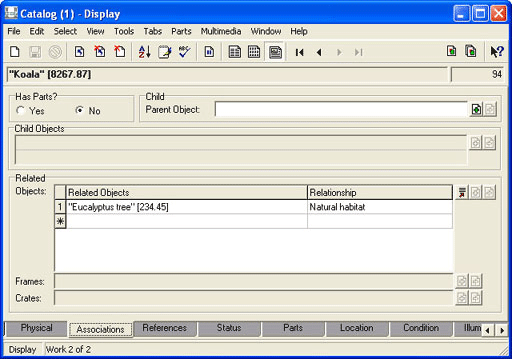EMu allows one object to be related to one or more objects. Examples of related objects are:
- A eucalyptus tree and the koala
- A parasite that is associated with a specific tree.

When an object (Item 1) is related to another object (Item 2) using the Objects: (Related) table, a reciprocal relationship can automatically be created for Item 2: the Objects: (Related) table for Item 2 will be updated to show that Item 1 is a related object.
Two points should be noted here:
- This relationship is not a reverse attachment.
- It is necessary for this functionality to be configured for your version of EMu.
Note: If a reciprocal relationship is not automatically created for the two objects, speak to your Systems Administrator or contact Axiell Support.
If a third object is related to the second object, the first object is not automatically related to the third object. For this reason, if the objects can be related in a hierarchical relationship, it is preferable to relate them using a parent / child relationship because the Parts function will automatically relate all objects in the same hierarchy together in the Parts tab.
Note: An object must already exist in the Catalog before an object can be related to it.
To attach a related object to another object:
- Search for or add a record for an object.
- Select the Associations tab.
- Place the cursor in the Object Name: (Related Objects) field.
- If you know the name of the related object, enter it in the Object Name: (Related Objects) field.
- Click Attach
 beside the field.
beside the field.A second copy of the Catalog module opens.
- Search for and select the related object(s).
- Click Attach Current Record
 or Attach Selected Records
or Attach Selected Records  in the Tool bar.
in the Tool bar.The Summary Data
 A one line summary of key fields in a record. In Details View the current record's Summary Data displays beneath the Tool bar; and a Target record's Summary Data displays in an attachment field when an attachment has been made. of the related object(s) is copied into the Object Name: (Related Objects) field and the objects are now related.
A one line summary of key fields in a record. In Details View the current record's Summary Data displays beneath the Tool bar; and a Target record's Summary Data displays in an attachment field when an attachment has been made. of the related object(s) is copied into the Object Name: (Related Objects) field and the objects are now related. - If additional objects are to be related, place the cursor in the row in the Object Name: (Related Objects) field with an asterisk and repeat steps 4 onwards.
Note: If there are many objects to be related, use the drag and drop method (see Using the drag and drop method).